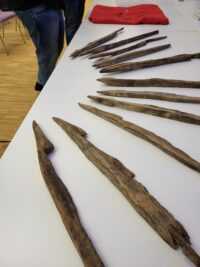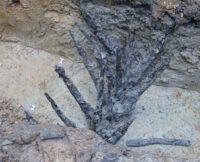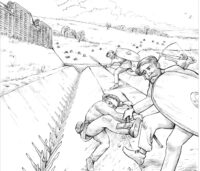
The spikes were discovered in a 2019 excavation at the site of two previously unknown early imperial military camps on the river Lahn. Found in a v-shaped trench still in their original upright or angled positions, ready to impale an unwary attacker, the carved wooden spikes were preserved in exceptional condition by the waterlogged clay soil. Known from ancient sources like Julius Caesar’s Gallic Wars, these are the first (and so far only) examples of this type of defensive barrier ever found.

The traces of the two Roman military camps, which were occupied for a few years around the middle of the 1st century AD, were uncovered as part of the three-year scientific project between 2017 and 2019. The evaluations could be completed in 2023. The camps are most likely related to the search for silver veins under the Roman governor Curtius Rufus, which was reported by the Roman historian Tacitus. The larger of the two camps, with an area of around 8 hectares, had space for 3,000 men. It was fortified with pointed ditches, an earthen rampart and wooden towers. This discovery was only made in 2016 by the volunteer monument conservator Jürgen Eigenbrod.
Until now, the area in the forest on the “Blöskopf” was considered a Roman ironworks since the 19th century due to its location above the Bad Ems silver mines and in the vicinity of historical mining traces (Pingenfelder). Due to its proximity to the Limes, it has been dated to the 2nd to 3rd centuries. After prospecting and excavations between 2018 and 2019, the researchers found that it was a small fort measuring approximately 0.1 hectares, which apparently served to control a Roman mining area around 50 AD. Inside this small fort is one of the second oldest stone buildings on the right of the Rhine, which could be identified as the central defensive structure in the complex.
* This article was originally published here








No comments:
Post a Comment